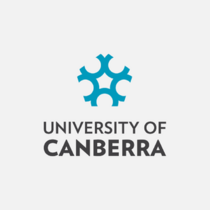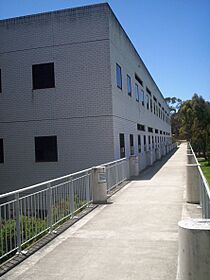University of Canberra facts for kids
 |
|
| Latin: Universitas Camberrensis | |
|
Former name
|
|
|---|---|
| Motto |
Galambany (Ngunnawal)
|
|
Motto in English
|
We all, including you |
| Type | Public research university |
| Established |
|
| Accreditation | TEQSA |
| Affiliation | Innovative Research Universities (IRU) |
|
Academic affiliations
|
|
| Budget | A$312.84 million (2022) |
| Chancellor | Lisa Paul |
| Vice-Chancellor | Lucy Johnston |
|
Total staff
|
1,185 regular (2022) 272 casual (2022) |
| Students | 11,246 (2022) |
| Undergraduates | 8,194 (2022) |
| Postgraduates | 2,228 (2022) |
|
Other students
|
|
| Address |
11 Kirinari Street
,
,
,
2617
,
|
| Campus | Urban, 296 acres (1.2 km2) |
| Colours | Teal |
|
Sporting affiliations
|
|
| Mascot | Cappie the Giraffe |
The University of Canberra (UC) is a public research university with its main campus located in Bruce, Canberra, Australian Capital Territory. The campus is within walking distance of Belconnen Town Centre, and 8.7 km (5.4 mi) from Canberra's Civic Centre. UC offers undergraduate and postgraduate courses covering five faculties: Health, Art and Design, Business, Government and Law, Education, and Science and Technology.
UC partners with two local ACT schools: UC Senior Secondary College Lake Ginninderra and University of Canberra High School Kaleen. The University of Canberra College provides pathways into university for domestic and international students.
Contents
History
The University of Canberra was first established in 1967 as the Canberra College of Advanced Education. The Canberra CAE became the University of Canberra under sponsorship of Monash University in 1990.
Over 70,000 students have graduated from the university since 1970.
The University of Canberra has grown by 78% since 2007, going from 7,300 students to over 13,000 in 2014. As of 2023, there are 10,785 students enrolled. The median Australian Tertiary Admission Rank of UC students is approximately 71.
Foundation stone and Stone Day
At the end of the year after classes finish but before exams, Stone Day was once held, a music festival with local bands, which lasted several days. The day before it was known as Stone Eve. It started as a celebration held annually to mark the placing of the foundation stone by Prime Minister John Gorton on 28 October 1968. The stone is displayed near Building 1 at the university, and an inscription on it reads:
This Stone was unveiled by the right honourable J.G. Gorton, M.P., Prime Minister of Australia, on 28 October 1968, to mark the establishment of the Canberra College of Advanced Education.
Over the years the Stone Day program gradually became larger and larger, eventually encompassing an entire week and transforming into one of Australia's most popular music festivals. The first foundation celebrations were held in 1971. In 1973 Stone Day celebrations were held over two days, which was expanded to take up a whole week in 1976. In the 1980s and 1990s, Stoneweek became a popular Canberra entertainment event, which in 2000 became Stonefest. Beginning in 2012, the Stonefest event was not held for a number of years at the University of Canberra. In 2014, the university decided to create a 'Stonefest' mini music festival where there was a DJ and numerous activities. It was not received well, and has not been held since. In June 2019 the University of Canberra announced that Stonefest would return in October in an expanded format, with both local and international acts performing.
Campus
The university has one campus, located in the suburb of Bruce, which covers 290 acres of buildings, roads and access routes. There are just over 28 buildings, each dedicated to a particular discipline of learning or faculty. Most of these buildings are arranged around the main concourse. Each building is numbered and many do not hold any title or namesake. New students are advised during orientation that the buildings are not numbered in a particular order, however the buildings around the concourse are progressively numbered in a counter-clockwise direction from building 1. It is a common myth that the numbers relate to when each building was constructed, however, a master plan was designed to have these building around the concourse numbered this way.
Library
The University of Canberra Library is located in Building 8. The building has four floors.
Facilities
The Refectory is the main food hall located in Building 1, operated by the UC Union. It provides cafes, post office, general shop, pool tables, and lounges, and is also concert venue. Upstairs there are study rooms which can be booked by students and staff.
The Hub is located under the main concourse, providing cafes, a hairdressing salon, and a branch of the Commonwealth Bank of Australia. The University of Canberra's student radio station 87.8 UCFM studios are also located in The Hub. The UC HUB also hosts DJs.
A sport and fitness centre is located in Building 29 with gym facilities and is home to Brumbies Rugby administration. There are basketball and squash courts nearby in Building 4, and various sporting ovals available.
Student accommodation
There are three accommodation options for students - UniLodge (consisting of Cooper Lodge, Weeden Lodge and more recently UC Lodge, all run by UniLodge Australia Pty Ltd), Campus West (run by UniLodge) and University Gardens (located in neighbour suburb of Belconnen, run by UniGardens Pty). All options are provided to all students, including international students.
Organisation and administration
Administration
The current chancellor of the university is Lisa Paul, AO PSM, a former senior Australian public servant and policymaker who was a long-serving Secretary of the Department of Education and Training.
The current interim vice-chancellor of the university is Professor Lucy Johnston. The previous vice-chancellor was Professor Paddy Nixon 20 April to January 2024. The former vice-chancellor from 1 September 2016 to 21 December 2019 was Professor Deep Saini, a plant physiologist. The previous vice-chancellor was Professor Stephen Parker.
Like most Australian universities, University of Canberra derives the majority of its revenue from Australian Government funding and student fees. The ACT Government provides around one percent of the university's operating budget.
Faculties
The five faculties are:
- Arts and Design
Arts and design specialises in architecture, landscape architecture, graphic design, communication studies, culture and heritage, journalism, creative writing and poetry, international studies, and media arts. The faculty has two schools: School of Design and the Built Environment and School of Arts and Communication.
- Business, Government and Law
The Business Government and Law Faculty provides courses in accounting, applied economics, business administration, business informatics, construction, economics, finance, law, management, marketing, politics, sociology, public policy, tourism, and urban and regional planning.
- Education
The Education faculty offers courses designed to cover all stages of teacher development with courses in early childhood, primary and secondary.
- Health
The Faculty of Health prepares allied health professionals, including nurses, midwives, occupational therapists, optometrists and vision scientists, psychologists, physiotherapists, pharmacists, dietitians, nutritionists, radiologists, speech pathologists, exercise scientists, and sports management professionals.
- Science and Technology
The Faculty of Science and Technology trains students in environmental sciences, biomedical and forensic as well as information technology, information systems, engineering, and mathematics.
UC also offers a range of double degrees that combine two degrees from different faculties.
Academic profile
Rankings
| University rankings | |
|---|---|
| University of Canberra | |
| QS World | =403 |
| THE World | 251–300 |
| ARWU World | 601–700 |
| US News World | 645 |
| Australian rankings | |
| QS National | 25 |
| THE National | 15 |
| ARWU National | 26–27 |
| US News National | 29 |
| ERA National | 33 |
The university is named among the world's top 20 young universities in the 2020 Times Higher Education (THE) Young University Rankings. The university rose to number 18 from number 34 in the 2019 THE list of the best universities under 50 years of age.
Research centres
The university has a number of research centres relating to its areas of research strength. These are:
- Institute for Applied Ecology
- Institute for Governance and Policy Analysis
- Research Institute for Sport and Exercise
- Health Research Institute
- Centre for Creative and Cultural Research
- News and Media Research Centre
- Centre for Research and Action in Public Health
- Centre for Research in Therapeutic Solutions
- STEM Education Research Centre
- SYNERGY Nursing and Midwifery Research Centre
- Nexus Research Centre
- Canberra Urban and Regional Futures
- Collaborative Indigenous Research Initiative
- Murray-Darling Basin Futures Collaborative Research Network
- Invasive Animals Cooperative Research Centre
Partnerships
On Saturday 17 June, 2023, UC announced a new one million dollar sponsorship of, and partnership with, Stromlo Forest Park that will expand its research and teaching activities across a range of sports, tourism, and business opportunities.
Notable people
Staff
Notable staff members include/have included:
- Janine Deakin, geneticist
- John Dryzek, political scientist
- Patricia Easteal, professor of law
- Donald Horne, journalist, writer, social critic, historian and public intellectual
- Peter Leahy, former Chief of Army (Australia)
- Ingrid Moses, emeritus professor and a former chancellor
- Susan Ryan, one-time Labor government minister
Alumni
See also
- List of universities in Australia
- University of Canberra (Wikiversity)
- University of Canberra Vikings




